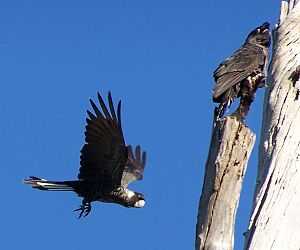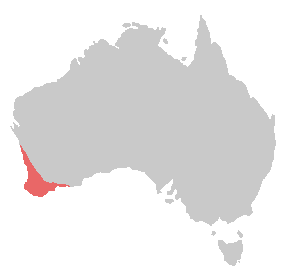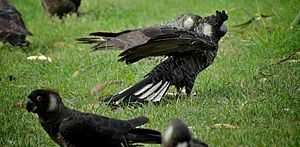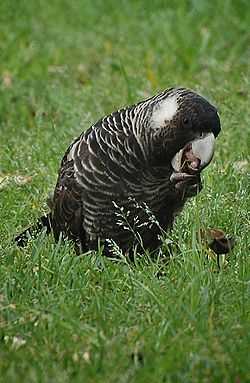Carnaby's black cockatoo
| Carnaby's black cockatoo | |
|---|---|
 | |
| Female flying and male perching on tree | |
| Conservation status | |
| Scientific classification | |
| Kingdom: | Animalia |
| Phylum: | Chordata |
| Class: | Aves |
| Order: | Psittaciformes |
| Superfamily: | Cacatuoidea |
| Family: | Cacatuidae |
| Subfamily: | Calyptorhynchinae |
| Genus: | Calyptorhynchus |
| Subgenus: | Zanda |
| Species: | C. latirostris |
| Binomial name | |
| Calyptorhynchus latirostris Carnaby, 1948 | |
 | |
| Range in red | |
Carnaby's black cockatoo (Calyptorhynchus latirostris), also known as Carnaby's cockatoo or short-billed black cockatoo,[2] is a large black cockatoo endemic to south-western Australia. It was described in 1948 by naturalist Ivan Carnaby. It is threatened by habitat destruction.
Description
Carnaby's black cockatoo is about 55 cm (21.5 in) long. It is mostly dark grey, with narrow light grey scalloping produced by narrow pale grey margins at the tips of dark feathers. It has a crest of short feathers on its head, with whitish patches of feathers that cover the ears. Its lateral tail feathers are white with black tips, and the central tail feathers all black. The irises are dark brown and the legs brown-grey. Its beak is shorter and broader than that of the closely related and similar long-billed black cockatoo.[3]
Adult males have a dark grey beak and pink eye-rings. Adult females have a bone coloured beak, grey eye-rings and ear patches that are paler than those of the males. Juveniles have a bone coloured beak, grey eye-rings, and less white in the tail feathers.[3]
Behaviour
Breeding
Mature Wandoo and Salmon Gum woodlands provide important breeding habitat for the cockatoos. There is competition for nest hollows with western corellas, galahs and feral honeybees.[4]
Feeding
The cockatoo feeds primarily on seeds of proteaceous plants such as Banksia, Hakea and Grevillea, and secondarily on seeds from myrtaceous plants such as Eucalyptus and Corymbia.[5] Over fifty native plant species are commonly used for food, either as seed or flowers, and this includes western sheoak, orange wattle, and balga.[5] Invertebrates such as the larvae of wood-boring moths are also eaten. The cockatoos also feed on the seeds of Pinus spp. in the Gnangara pine plantations north of Perth.
Typically, birds sit in the crowns of trees cracking the seed pods or cones, but occasionally they forage for fallen seed on the ground.
Status and conservation
The cockatoo is recognised as Endangered under the federal Environment Protection and Biodiversity Conservation Act 1999,[6] and as Schedule 1 "fauna that is rare or is likely to become extinct" by Western Australia's Wildlife Conservation (Specially Protected Fauna) Notice 2008(2) under the Wildlife Conservation Act 1950. The population size of Carnaby's cockatoo fell by over 50% over 45 years, and up to a third of their traditional breeding grounds in the Wheatbelt region have been abandoned.[7]
Major threats to the cockatoo include clearance of their feeding and nesting habitat, destruction of nesting hollows (e.g. during firewood collection), competition with other species for nest sites, and poaching.[4]
Important Bird Areas
Sites identified by BirdLife International as being important for Carnaby's black cockatoo conservation are:[8]
Gallery
-

Flock on the ground in Kings Park
-

Feeding in Kings Park
-

At Rainbow Jungle, Kalbarri, Western Australia
References
- ↑ BirdLife International (2013). "Calyptorhynchus latirostris". IUCN Red List of Threatened Species. Version 2013.2. International Union for Conservation of Nature. Retrieved 26 November 2013.
- ↑ Christidis, Les and Walter E. Boles (2008) Systematics and Taxonomy of Australian Birds ISBN 978-0-643-06511-6
- ↑ 3.0 3.1 Forshaw (2006). plate 1.
- ↑ 4.0 4.1 "Australian Threatened Species: Carnaby's Black-Cockatoo". Department of the Environment, Water, Heritage and the Arts. Retrieved 2009-05-19.
- ↑ 5.0 5.1 Valentine, Leonie E.; Stock, William (December 2008). "Food resources of Carnaby's Black Cockatoo (Calyptorhynchus latirostris) in the Gnangara Sustainability Strategy Study Area". Edith Cowan University & Department of Environment and Conservation. Retrieved 2009-05-19.
- ↑ Australian Government: Department of the Environment, Water, Heritage and the Arts Calyptorhynchus latirostris
- ↑ Department of the Environment, Water, Heritage and the Arts. "National Threatened Species Day 2008: Carnaby's black-cockatoo Calyptorhynchus latirostris". Retrieved 2009-05-19.
- ↑ "Short-billed Black Cockatoo". Important Bird Areas. BirdLife International. 2012. Retrieved 2012-10-30.
Cited texts
- Forshaw, Joseph M. (2006). Parrots of the World; an Identification Guide. Illustrated by Frank Knight. Princeton University Press. ISBN 0-691-09251-6.
External links
- BirdLife Species Factsheet
- Australian Government website - threatened Australian species
- Western Australian Museum Cockatoo Care website
| ||||||||||||||||||||||||||||||||||||||||||||||||||||||||||||||
